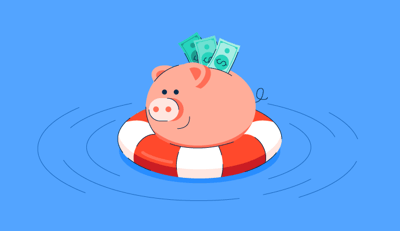
Beyond stock and loans, companies have another tool to raise money: corporate bonds.
A corporate bond is a loan given by an investor to a company seeking to raise money for running and growing a business in exchange for interest payments and the return of the principal at a future date.
Companies sell these bonds when they need capital to pay bills, buy new equipment, fund research projects, buy back shares, or manage existing debt. Institutional investors, who manage large amounts of money for their clients using portfolio management tools, traders, and even retailer buyers, buy corporate bonds to diversify their portfolios.
Let's understand the concept of corporate bonds better by comparing them to their equity counterparts to determine if they're a good investment for your portfolio.
When you buy a share of a company's stock, say Coca-Cola, you're essentially buying a tiny piece of ownership in the company. You're like a mini-partner. This ownership comes with potential benefits like dividends and share price increases that you can profit from. With stocks, the price fluctuates, so there's no guarantee that you'll get the return on investment (ROI).
Now, when you buy corporate bonds of Coca-Cola, you're like a creditor. You get an already-decided interest amount and your original investment back when the bond matures after some time. But unlike stocks, you get a fixed return with bonds, and if the company defaults, bondholders are paid before stockholders.
Corporate bonds are considered relatively safer than stocks. However, investors should keep a couple of things in mind when buying corporate bonds of a company.
The company's creditworthiness is judged by the credit ratings given by global rating agencies like Moody's, Fitch Ratings, Standard & Poor, CRISIL, etc. The lower the company’s credit quality, the higher the default risk. However, to attract more investors' attention, companies may also issue bonds with a higher interest rate.
Bond credit rating indicates the bond issuer's likelihood of repaying the principal and interest on time and in full.
The credit rating scale generally ranges from AAA to D, with AAA representing the highest rating of creditworthiness and D, the lowest. The higher the credit rating, the lower the risk and, hence, the interest and return. The lower the credit rating, the higher the risk and returns.
Most bonds have a coupon payment structure, which typically means that each year, a set amount of interest is paid back to the investor until the bond’s maturity date, at which point the company reimburses the lender for its original investment.
There are exceptions to this standard coupon structure, like zero-coupon bonds. Such bonds gain interest just like regular bonds; however, the investor does not receive any interest payments until the maturity date.
The maturity date is the date on which the company repays the bond's face value to investors. Longer maturities generally entail higher interest rates to compensate investors for the extended repayment period.
While corporate bonds offer a fixed interest rate, their market price can fluctuate before maturity, impacted by factors like interest rates, the company's credit risk, and overall market conditions.
For instance, bond prices have an inverse relationship with interest rates. When interest rates increase, bond prices fall for existing bonds as they become less attractive than newly issued bonds with higher interest rates.
Corporate bonds come in different categories, each with a risk and return profile. Here are some common types:
Investment-grade bonds are issued by financially stable companies and offer lower risk and interest rates. They are favored by conservative investors seeking steady income.
High-yield bonds, or junk bonds, are issued by companies with companies with lower credit ratings or higher risk of default. They offer higher interest rates to compensate investors for the increased risk of default.
Fixed-rate bonds offer a constant interest payment throughout the life of the bond. While fixed-rate bonds offer stability, they are susceptible to interest rate risk. If market interest rates rise after the bond is issued, the fixed interest payments may become less attractive than newly issued bonds offering higher rates. As a result, the market value of existing fixed-rate bonds may decline.
Floating-rate bonds have interest payments that fluctuate based on a benchmark rate, like the Consumer Price Index (CPI). These bonds are less sensitive to interest rate fluctuations than fixed-rate bonds, making them suitable for investors concerned about rising interest rates.
Callable bonds allow the issuing company to repurchase the bond before maturity at a set price. Puttable bonds allow investors to sell the bond back to the company before maturity.
As the name suggests, secured bonds are backed by the company's collateral. In the event of default, bondholders have a claim on the collateral, which provides added security. Mortgage-backed securities (MBS) and asset-backed securities (ABS) are examples of secured bonds.
Unsecured bonds, also known as debentures, don't have the collateral backing. Instead, they rely solely on the creditworthiness and general assets of the issuing company for repayment. So, these bonds typically offer higher interest rates than secured bonds
Short-term bonds have the lowest risk and lowest return. Their terms are three years or less. If the bond’s term is shorter, there is less time for the company to go bankrupt (thus, less default risk). There is also less time for the company to decide to call the bond, buy it back from the investor, or for federal interest rates to change unfavorably. On the flip side, there is also less time for short-term bonds to gain interest, giving them a lower return rate than other types of bonds.
Medium-term bonds are just that: bonds with terms in between long and short-term bonds. The length of these terms is four to 10 years. Consequently, they are a middle ground, offering medium risk and medium return on investment.
Long-term bonds are a high-risk investment but have the highest return. Their terms are 10 years or more. There’s more time within the term for things to go wrong for the lender: the company may not make enough money over time to pay off the debt (causing higher default risk), federal interest rates may rise above the bond’s interest rate, or the bond may be called. They are also sometimes called high-yield corporate bonds because, if all goes well, they can make the most money for investors.
Convertible bonds are bonds that can be converted into a certain number of shares of the issuing company's common stock. These bonds offer the potential for capital appreciation if the company's stock price rises but also provide downside protection through the fixed-income aspect as it provides interest too.
For example, software company MicroStrategy is issuing $500 million in convertible bonds that will mature in 2031 with an option to convert the bond when the stock climbs 40% to 45% above its current levels.
Similarly, companies like Super Micro Computer, Global Payments, and Lyft have issued convertible bonds in 2024 with options to convert the loan to shares.
These common investment options come with different risks and returns; the choice between them depends on your portfolio strategy.
To summarise, based on risk and return profile, if you want safety first: government securities; balance: corporate bonds; growth potential: stocks.
So, you know about the various features, risks, and benefits that come along with different types of corporate bonds, but you can’t decide if they are right for you and which one you can buy. Corporate bonds can be a good investment depending on your investment goals and risk tolerance.
Consider your goals: If you prioritize steady income and capital preservation, investment-grade corporate bonds can be a good fit.
Risk tolerance: If you're comfortable with some risk, you can explore a mix of bonds and stocks to achieve a balance between income and growth potential.
Investment horizon: Bonds can be a good option for short- to medium-term investments where you might need the principal back sooner.
Remember, it's wise to consult a financial advisor to discuss your specific situation and decide if corporate bonds align with your overall investment strategy.
Corporate bonds are a great way for companies to raise money for expansion, and for buyers to invest their savings, but only if both parties know the ropes. So long as they do, investors in corporate bonds need not do more than sit back, watch the interest flow in, and enjoy a martini. Shaken, not stirred.
Still unsure of how to issue or invest in corporate bonds? Financial services software is here to help.
This article was originally published in 2019 and has been updated with new information.
Maddie is a former content specialist at G2. She also has a passion for music and cats. (she/her/hers)
Debt can be scary when you’re paying off college loans or deciding whether to use credit to...
 by Maddie Rehayem
by Maddie Rehayem
Abiding by the law has wiggled its way into our daily routines.
 by Mary Clare Novak
by Mary Clare Novak
In the world of corporate bonds, risk management is everything.
 by Harshita Tewari
by Harshita Tewari
Debt can be scary when you’re paying off college loans or deciding whether to use credit to...
 by Maddie Rehayem
by Maddie Rehayem
Abiding by the law has wiggled its way into our daily routines.
 by Mary Clare Novak
by Mary Clare Novak


